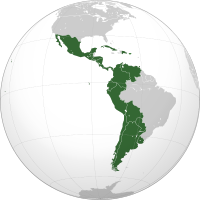
Photo from wikipedia
Objectives: Despite knowledge that the Hispanic population is growing in the United States and that birth outcomes may vary by maternal country of birth, data on birth outcomes by maternal… Click to show full abstract
Objectives: Despite knowledge that the Hispanic population is growing in the United States and that birth outcomes may vary by maternal country of birth, data on birth outcomes by maternal country of birth among Hispanic women are scant. We compared the rates of 3 birth outcomes for infants born in the United States—preterm birth, low birth weight, and small for gestational age—between foreign-born Hispanic women and US-born Hispanic women, and then we examined these birth outcomes by mother’s country of birth for foreign-born Hispanic women. Methods: Using the 2013 natality file from the National Vital Statistics System of the National Center for Health Statistics, we examined data on the 3 birth outcomes and maternal characteristics by maternal country of birth. We used log binomial models to calculate unadjusted and adjusted relative risks for preterm birth, low birth weight, and small for gestational age for US-born Hispanic women compared with foreign-born Hispanic women. We also compared the relative risk of each adverse birth outcome for foreign-born Hispanic women by country of birth. Results: US-born Hispanic women had higher rates of the 3 birth outcomes than did foreign-born Hispanic women (preterm birth: 8.0% vs 7.0%; low birth weight: 6.1% vs 5.2%; small for gestational age: 9.2% vs 7.9%). These higher rates persisted after adjusting for maternal characteristics. The rates for these 3 birth outcomes varied significantly by country of birth for foreign-born Hispanic women, with Puerto Rican women consistently having the poorest birth outcomes. Conclusions: Our results demonstrated heterogeneity in rates of adverse birth outcomes by country of birth for foreign-born Hispanic women. Presenting rates for foreign-born mothers as a group masks differences by country. To understand possible changes in data on birth outcomes, states should stratify data by maternal country of birth.
Journal Title: Public Health Reports
Year Published: 2018
Link to full text (if available)
Share on Social Media: Sign Up to like & get
recommendations!